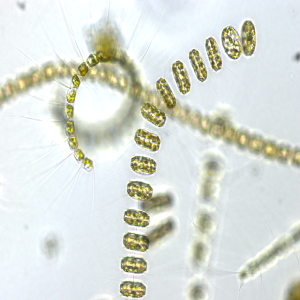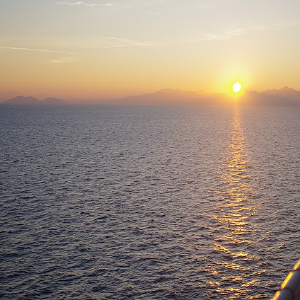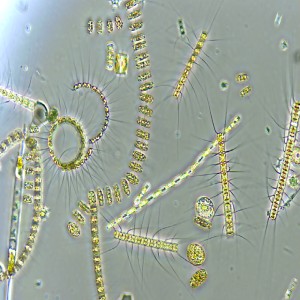Macrobenthos of lagoon ecosystems: a comparison in vegetated and bare sediments

Accepted: 8 March 2023
HTML: 49
All claims expressed in this article are solely those of the authors and do not necessarily represent those of their affiliated organizations, or those of the publisher, the editors and the reviewers. Any product that may be evaluated in this article or claim that may be made by its manufacturer is not guaranteed or endorsed by the publisher.
The classic paradigm, not always unequivocal though, that seagrass macrobenthic abundance and diversity are greater than those in adjacent unvegetated areas, was tested in a Mediterranean lagoon for which evidence is lacking. We compared the community structure and species composition of macrobenthic assemblages in three distinct areas of the Mistras Lagoon (Sardinia, Italy) dominated by i) the seagrass Cymodocea nodosa (Cym), ii) mixed-macrophyte/detritus (Mix), and iii) unvegetated sediments (Unv). Samplings were conducted in each area twice in spring (April and May) and twice in autumn (October and November) 2010. Multivariate analyses showed significant differences among the three areas and a marked separation between the two vegetated (Cym and Mix) and the unvegetated (Unv) areas. The top discriminating species, indicated by SIMPER analysis, were characterized by direct development lacking free living larvae. They included marine species, e.g. Cerithium lividulum, Microdeutopus gryllotalpa, Loripes orbiculatus and Gammarus aequicauda, at Cym vs Mix, whereas the pair discrimination of the areas Cym vs Unv and Mix vs Unv mostly depended on the marine Abra tenuis, the opportunistic Chironomidae and Capitella capitata, and the brackish Hydrobia acuta. Both vegetated areas showed a higher species number than the unvegetated area. Differently, abundance was higher in Unv than in Cym and Mix in all sampling dates, most notably in spring likely because of reproductive events, due to both opportunistic (C. capitata, chironomids) and halolimnobic (H. acuta, Cerastoderma glaucum) species. Overall, the present study demonstrated the importance of biological factors in structuring the macrobenthic assemblages of the Mistras Lagoon. Habitat-forming phanerogams hosted species-rich assemblages, species-specific reproductive cycles and adaptive strategies contributed to drive species colonization and abundance distribution. Both vegetated and unvegetated patches were found to contribute greatly to the local-scale heterogeneity of the habitat, highlighting the importance of coastal lagoons as hotspots for benthic biodiversity. For these reasons, lagoons must be considered major targets for conservation measures.
Bachelet G, de Montaudouin X, Auby I, Labourg PJ, 2000. Seasonal changes in macrophyte and macrozoobenthos assemblages in three coastal lagoons under varying degrees of eutrophication. ICES J. Mar. Sci. 57:1495-506. DOI: https://doi.org/10.1006/jmsc.2000.0902
Barnes RSK, 2013a. Distribution patterns of macrobenthic biodiversity in the intertidal seagrass beds of an estuarine system, and their conservation significance. Biodivers. Conserv. 22:357–72. DOI: https://doi.org/10.1007/s10531-012-0414-z
Barnes RSK, 2013b. Spatial stability of macrobenthic seagrass biodiversity. Mar. Ecol. Progr. Ser. 493:127–39. DOI: https://doi.org/10.3354/meps10546
Barnes RSK, 2020a. Do different sympatric seagrasses support macrobenthic faunas of differing composition, abundance, biodiversity or patchiness? Mar. Environ. Res. 160:104983. DOI: https://doi.org/10.1016/j.marenvres.2020.104983
Barnes RSK, 2020b. Do species display characteristic intraspecific levels of patchiness in a given habitat type? The case of intertidal seagrass macrobenthos. Mar. Biol. 167:1-12. DOI: https://doi.org/10.1007/s00227-020-03793-9
Barnes RSK, 2021. Patterns of seagrass macrobenthic biodiversity in the warm-temperate Knysna estuarine bay, Western Cape: a review. Aquat. Ecol. 55:327–45. DOI: https://doi.org/10.1007/s10452-021-09848-3
Barnes RSK, 2022. Biodiversity differentials between seagrass and adjacent bare sediment change along an estuarine gradient. Estuar. Coast. Shelf Sci. 274:107951. DOI: https://doi.org/10.1016/j.ecss.2022.107951
Barnes RSK, 2023. Seagrass macrobenthic biodiversity does not vary in conformity with a leaky-lagoonal confinement gradient. Mar. Environ. Res. 185:105897. DOI: https://doi.org/10.1016/j.marenvres.2023.105897
Barnes RSK, Barnes MKS, 2012. Shore height and differentials between macrobenthic assemblages in vegetated and unvegetated areas of an intertidal sandflat. Estuar. Coast. Shelf Sci. 106:112–20. DOI: https://doi.org/10.1016/j.ecss.2012.05.011
Barnes RSK, Barnes MKS, 2014. Biodiversity differentials between the numerically dominant macrobenthos of seagrass and adjacent unvegetated sand in the absence of sandflat bioturbation. Mar. Environ. Res. 99:34–43. DOI: https://doi.org/10.1016/j.marenvres.2014.05.013
Barnes RSK, Claassens L, Seath J, 2022. Where ecologically ‘tis better to go brown than green: enhanced seagrass macrobenthic biodiversity within the canals of a brownfield coastal marina. Biodivers. Conserv. 31:2981–97. DOI: https://doi.org/10.1007/s10531-022-02468-9
Barnes RSK, Hamylton S, 2016. On the very edge: faunal and functional responses to the interface between benthic seagrass and unvegetated-sand assemblages. Mar. Ecol. Prog. Ser. 553:33–48. DOI: https://doi.org/10.3354/meps11800
Blanchet H, de Montaudouin X, Chardy P, Bachelet G, 2005. Structuring factors and recent changes in subtidal macrozoobenthic communities of a coastal lagoon, Arcachon Bay (France). Estuar. Coast. Shelf Sci. 64:561-76. DOI: https://doi.org/10.1016/j.ecss.2005.03.016
Brito MC, Martin D, Núñez J, 2005. Polychaetes associated to a Cymodocea nodosa meadow in the Canary Islands: assemblage structure, temporal variability and vertical distribution compared to other Mediterranean seagrass meadows. Mar. Biol. 146:467–81. DOI: https://doi.org/10.1007/s00227-004-1460-1
Brundu G, Magni P, 2021. Context-dependent effect of serpulid reefs on the variability of soft-bottom macrobenthic assemblages in three Mediterranean lagoons (Sardinia, Italy). Estuar. Coast. Shelf Sci. 262:107589. DOI: https://doi.org/10.1016/j.ecss.2021.107589
Camarda I, 1995. Un sistema di aree di interesse botanico per la salvaguardia della biodiversità floristica della Sardegna. Bollettino della Società Sarda di Scienze Naturali, 30:245-95.
Cardone F, Corriero G, Fianchini A, et al., 2014. Biodiversity of transitional waters: species composition and comparative analysis of hard bottom communities from south-eastern Italian coast. J. Mar. Biol. Ass. UK 94:25–34. DOI: https://doi.org/10.1017/S0025315413001306
Como S, Magni P, Baroli M, et al., 2008. Comparative analysis of macrofaunal species richness and composition in Posidonia oceanica, Cymodocea nodosa and leaf litter beds. Mar. Biol. 153:1087-101. DOI: https://doi.org/10.1007/s00227-007-0881-z
Como S, Magni P, Van Der Velde G, et al., 2012. Spatial variations in δ13C and δ15N values of primary consumers in a coastal lagoon. Estuar. Coast. Shelf Sci. 115:300-8. DOI: https://doi.org/10.1016/j.ecss.2012.07.032
Currás, A, Mora J, 1996. Aspectos de la dinámica de poblaciones de Loripes lacteus (Linnaeus, 1758) (Mollusca, Bivalvia) en fondos Zostera spp. de la ría del Eo (NO de España). Nova Acta Científica Compostelana (Bioloxía) 6:167-78.
Evangelisti F, Bonfitto A, Morassi M, Sabelli B, 2016. How many native Cerithium species in the Mediterranean Sea. An integrative taxonomic approach. J. Mollusc. Stud. 82:292–304. DOI: https://doi.org/10.1093/mollus/eyv066
Fenzi GA, 2013. Variabilità spazio-temporale dei popolamenti macrozoobentonici in relazione ai cambiamenti stagionali in un ambiente lagunare (Mistras, Sardegna Occidentale) con basso impatto antropico ed elevata stabilità ecologica. Tesi dottorale, Università degli Studi della Tuscia. Viterbo, Italy.
García-Gómez G, García‐Herrero Á, Sánchez N, et al., 2022. Meiofauna is an important, yet often overlooked, component of biodiversity in the ecosystem formed by Posidonia oceanica. Invert. Biol. 141:e12377. DOI: https://doi.org/10.1111/ivb.12377
Garilli V, Galletti L, 2006. Taxonomical characters for distinguishing Cerithium lividulum Risso, 1826, and C. renovatum Monterosato, 1884 (Gastropoda, Caenogastropoda, Cerithiidae). Basteria, 70:109-22.
Gravina MF, Cabiddu S, Como S, et al, 2020b. Disentangling heterogeneity and commonalities in nanotidal Mediterranean lagoons through environmental features and macrozoobenthic assemblages. Estuar. Coast. Shelf Sci. 237:106688. DOI: https://doi.org/10.1016/j.ecss.2020.106688
Holmes SP, Dekker R, Williams DI, 2004. Population dynamics and genetic differentiation in the bivalve mollusc Abra tenuis: aplanic dispersal. Mar. Ecol. Prog. Ser. 268:131–40. DOI: https://doi.org/10.3354/meps268131
Hu C, Liu Y, Yang X, et al., 2022. Functional trait responses of macrobenthic communities in seagrass microhabitats of a temperate lagoon. Mar. Pollut. Bull. 177:113491. DOI: https://doi.org/10.1016/j.marpolbul.2022.113491
Leopardas V, Honda K, Go GA, et al., 2016. Variation in macrofaunal communities of sea grass beds along a pollution gradient in Bolinao, northwestern Philippines. Mar. Poll. Bull. 105:310-8. DOI: https://doi.org/10.1016/j.marpolbul.2016.02.004
Leopardas V, Uy W, Nakaoka M, 2014. Benthic macrofaunal assemblages in multispecific seagrass meadows of the southern Philippines: variation among vegetation dominated by different seagrass species. J. Exp. Mar. Biol. Ecol. 457:71-80. DOI: https://doi.org/10.1016/j.jembe.2014.04.006
Lepoint G, Hyndes GA, 2022. Tropicalization of seagrass macrophytodetritus accumulations and associated food webs. Front. Mar. Sci. 9:943841. DOI: https://doi.org/10.3389/fmars.2022.943841
Magni P, Como S, Cucco A, et al., 2008a. A multidisciplinary and ecosystemic approach in the Oristano Lagoon-Gulf System (Sardinia, Italy) as a tool in management plans. Transit. Water Bull. 2:41-62.
Magni P, Como S, Kamijo A, Montani S, 2017. Effects of Zostera marina on the patterns of spatial distribution of sediments and macrozoobenthos in the boreal lagoon of Furen (Hokkaido, Japan). Mar. Environ. Res. 131C:90-102. DOI: https://doi.org/10.1016/j.marenvres.2017.09.013
Magni P, Micheletti, S, Casu D, et al., 2005. Relationships between chemical characteristics of sediments and macrofaunal communities in the Cabras lagoon (western Mediterranean, Italy). Hydrobiologia 550:109-15. DOI: https://doi.org/10.1007/s10750-005-4367-z
Magni P, Rajagopal S, van der Velde G, et al., 2008b. Sediment features, macrozoobenthic assemblages and trophic relationships (δ13C and δ15N analysis) following a dystrophic event with anoxia and sulphide development in the Santa Giusta lagoon (western Sardinia, Italy). Mar. Pollut. Bull. 57:125-36. DOI: https://doi.org/10.1016/j.marpolbul.2007.10.015
Murenu M, Olita A, Sabatini A, Follesa MC, Cau A, 2004. Dystrophy effects on the Liza ramada (Risso, 1826) (Pisces, Mugilidae) population in the Cabras lagoon (central-western Sardinia). Chem. Ecol. 20(S1):S425–S433. DOI: https://doi.org/10.1080/02757540410001665933
Nakaoka M, 2005. Plant-animal interactions in seagrass beds: ongoing and future challenges for understanding population and community dynamics. Popul. Ecol. 47:167–77. DOI: https://doi.org/10.1007/s10144-005-0226-z
Nonnis Marzano C, Gravina MF, Fianchini A, et al., 2010. The macrozoobenthos of the Karavasta lagoon system (Albania): local assemblages and geographical comparisons. Mar. Ecol. 31:622–32. DOI: https://doi.org/10.1111/j.1439-0485.2010.00381.x
Ólafsson E, Aarnio K, Bonsdorff E, Arroyo NL, 2013. Fauna of the green alga Cladophora glomerata in the Baltic Sea: density, diversity, and algal decomposition stage. Marine Biology 160: 2353–62. DOI: https://doi.org/10.1007/s00227-013-2229-1
Padedda BM, Pulina S, Magni P, et al., 2012. Phytoplankton dynamics in relation to environmental changes in a phytoplankton-dominated Mediterranean lagoon (Cabras Lagoon, Italy). Adv. Limnol Oceanogr. 3:147-169. DOI: https://doi.org/10.1080/19475721.2012.716792
Pascucci V, De Falco G, Del Vais C, et al., 2018. Climate changes and human impact on the Mistras coastal barrier system (W Sardinia, Italy). Mar. Geol. 395:271-84. DOI: https://doi.org/10.1016/j.margeo.2017.11.002
Perez M, Duarte CM, Romero J, et al., 1994. Growth plasticity in Cymodocea nodosa stands: the importance of nutrient supply. Aquat Bot 47:249–64. DOI: https://doi.org/10.1016/0304-3770(94)90056-6
Pulina S, Satta CT, Padedda BM, et al., 2018. Seasonal variations of phytoplankton size structure in relation to environmental variables in three Mediterranean shallow coastal lagoons. Estuar. Coast. Shelf Sci. 212:95-104. DOI: https://doi.org/10.1016/j.ecss.2018.07.002
Ramsar Convention, 1971. Convention on wetlands of international importance especially as waterfowl habitat. Ramsar (Iran), 2 February 1971. UN Treaty Series No. 14583. As amended by the Paris Protocol, 3 December 1982, and Regina Amendments, 28 May 1987. Available from: http://www.ramsar.org/key_conv_e.html.
Satta CT, Anglès S, Garcés E, et al, 2014. Dinoflagellate cyst assemblages in surface sediments from three shallow Mediterranean lagoons (Sardinia, North Western Mediterranean Sea). Estuar. Coast. 37:646-63. DOI: https://doi.org/10.1007/s12237-013-9705-1
Sechi N, 1982. Lo stato trofico di alcuni stagni salmastri costieri della Sardegna. Boll. Soc. Sarda Sci. Nat. 21:285-95.
Sfriso A, Birkemeyer T, Ghetti PF, 2001. Benthic macrofauna changes in areas of Venice lagoon populated by seagrasses or seaweeds. Mar. Environ. Res. 52:323-49. DOI: https://doi.org/10.1016/S0141-1136(01)00089-7
Specchiulli A, Cilenti L, D'Adamo R, et al, 2018. Dissolved organic matter dynamics in Mediterranean lagoons: The relationship between DOC and CDOM. Mar. Chem. 202:37-48. DOI: https://doi.org/10.1016/j.marchem.2018.02.003
Surugiu V, Teacâ A, Svedu I, Quijón PA, 2021. A Hotspot in the Romanian Black Sea: Eelgrass Beds Drive Local Biodiversity in Surrounding Bare Sediments. Front. Mar. Sci. 8:745137. DOI: https://doi.org/10.3389/fmars.2021.745137
Tagliapietra D, Pessa G, Cornello M, et al., 2016. Temporal distribution of intertidal macrozoobenthic assemblages in a Nanozostera noltii-dominated area (Lagoon of Venice). Mar. Environ. Res. 114:31-9. DOI: https://doi.org/10.1016/j.marenvres.2015.11.009
Włodarska-Kowalczuk M, Jankowska E, Kotwicki L, Balazy P, 2014. Evidence of season-dependency in vegetation effects on macrofauna in temperate seagrass meadows (Baltic Sea). PLoS One 9:e100788. DOI: https://doi.org/10.1371/journal.pone.0100788
Yamada K, Hori M, Tanaka Y, et al., 2007. Temporal and spatial macrofaunal community changes along a salinity gradient in seagrass meadows of Akkeshi-ko estuary and Akkeshi Bay, northern Japan. Hydrobiologia 592:345-58. DOI: https://doi.org/10.1007/s10750-007-0767-6
Zheng X, Como S, Huang L, Magni P, 2020. Temporal changes of a food web structure driven by different primary producers in a subtropical eutrophic lagoon. Mar. Environ. Res. 161:105-28. DOI: https://doi.org/10.1016/j.marenvres.2020.105128
Copyright (c) 2023 The Author(s)

This work is licensed under a Creative Commons Attribution-NonCommercial 4.0 International License.
PAGEPress has chosen to apply the Creative Commons Attribution NonCommercial 4.0 International License (CC BY-NC 4.0) to all manuscripts to be published.



 https://doi.org/10.4081/aiol.2023.11124
https://doi.org/10.4081/aiol.2023.11124







